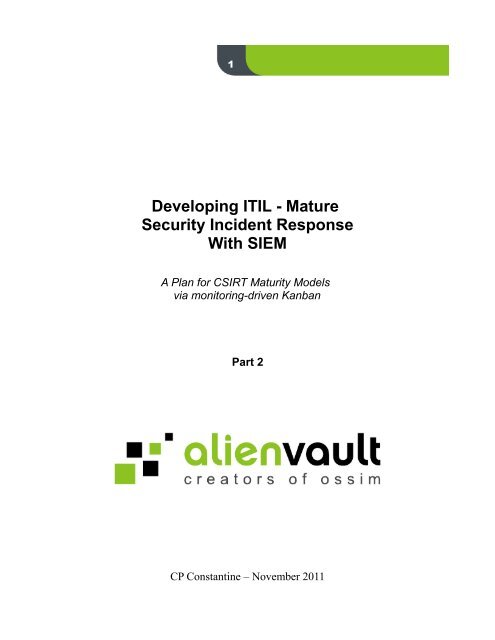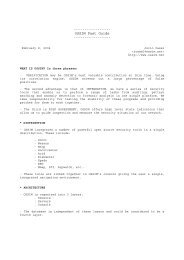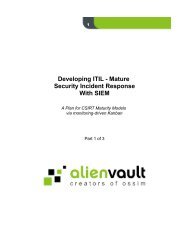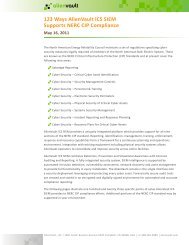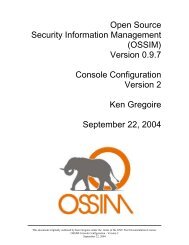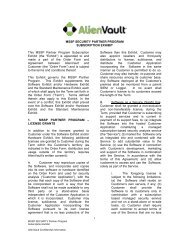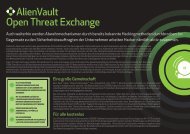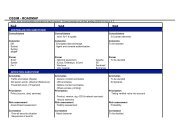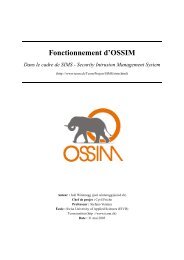SIEM for ITIL Incident Response - Part 2 - AlienVault
SIEM for ITIL Incident Response - Part 2 - AlienVault
SIEM for ITIL Incident Response - Part 2 - AlienVault
You also want an ePaper? Increase the reach of your titles
YUMPU automatically turns print PDFs into web optimized ePapers that Google loves.
2ForewordIn the previous installation of this series, we took a short overview of the current status of <strong>Incident</strong><strong>Response</strong> workflows and conjectured on possible models <strong>for</strong> maturity evolution of the ComputerSecurity <strong>Incident</strong> <strong>Response</strong> service model.This series of documents centers on the following assertions.• The current status quo <strong>for</strong> effective Computer Security <strong>Incident</strong> <strong>Response</strong>is actually a very immature service model in comparison to other ServiceDomains within In<strong>for</strong>mation Technology in the Enterprise.• Evolving IR into a more mature service model, will produce largequantities of valuable data <strong>for</strong> business intelligence and metrics.• The in<strong>for</strong>mation necessary to build this more mature model, does notactually create additional ongoing workload <strong>for</strong> <strong>Incident</strong> <strong>Response</strong> Teams,but actually acts as a <strong>for</strong>ce-multiplier to make existing work more effectiveand efficient.
4The Five States of Capability, Applied to Security <strong>Incident</strong><strong>Response</strong>.Picking up where we left of, let's take a look at currently-seen <strong>Incident</strong> <strong>Response</strong> workflows incomparison to the Capability Maturity Model Integration definitions. CMMI works well as acomplementary model to <strong>ITIL</strong>, defining very similar measurements of Service Delivery ability.Moreover, it serves as an excellent illustrator of the broad space of opportunity to improveupon current best practices in <strong>Incident</strong> <strong>Response</strong> into new operational service models.1 - Initial“Processes Unpredictable, poorly controlled and Reactive”There are no dedicated <strong>Incident</strong> response personnel, detection of intrusion is left purely to thevigilance of individuals within the organization. If a breach is detected, panic mode is engagedand a temporary team is assembled from whatever expertise is available within theorganization, or an outside agency is contracted. In the optimal outcome, this stage is neverrepeated and work commences immediately to more to stage 2.• <strong>Incident</strong> <strong>Response</strong> as ad-hoc disaster recovery• Point-in-time emergency teams <strong>for</strong>med from available SME's• All process is created on the fly by the team. Workflow is according to personaljudgment or emerging data.• Usually no record of what work was done or its effectiveness, beyond theindividual memory of the team.• Metrics are impossible since nothing is repeatable.• Intelligence data is neither produced nor actively consumedTypical Configuration:None: The emergency team must make use of whatever systems, logs and personalexperience they have. Tracking is individualized with collaboration systems often limited to afile directory and a white board. Operational Procedure usually limited to 'Don't Panic!'
5Flow DiagramWe’ve been Breached !Whatever Evidenceis AvailableAny Available SMEsAttempt to Reconstruct the Scene of the CrimeDon’t Panic!Let’s Never Do This Again!
62 - Managed“Processes Characterized <strong>for</strong> Projects, and is often reactive”At this stage, roughly repeatable <strong>Incident</strong> <strong>Response</strong> procedures have been defined, and somesemblance of ongoing process is in place. This can range from an agreed-upon amount of timeexercised per week in reviewing logs, to a quantity of dedicated personnel responding to alinear queue of alerts from security controls, and incident reports from the enterprise. Alertsare based entirely from technical observations from Security Controls and are not tied to howthe Enterprise does business; much time is spent tuning controls <strong>for</strong> false positives.Processes and procedures are driven entirely by technology, and little record correlation existsbetween investigative work and business processes. Prioritization of work queues are done byarbitrary measures of criticality that remain fixed. Metrics are often at the level of standalonenumbers that lack the required compartmentalization to map them to overall businessprocesses.• <strong>Incident</strong> <strong>Response</strong> as intermittent quality testing or work ticketing -The 'Reviewduring downtime” and “Linear Event Models”. Workflow often resembles ahelpdesk style model.• Initially dedicated hours and then dedicated staffing. Usually requires high-skillpersonnel able to follow loose processes and operate under their ownspecialized technical knowledge.• Processes are loosely-defined, with no Key Per<strong>for</strong>mance Indicators. Procedureis often according to personal judgment with broadly-defined scopes ofresponsibility.• Improvements are identified and measured by perception and consensus only• Metrics rarely evolve beyond the level of raw numbers, and are not translatableto support the metrics of other business units.• Intelligence data is consumed from external sources, but processed manually.Intelligence data is only produced as an incidental finding that lacksrepeatability.Typical Configuration:Alerts generated and tracked directly in the security controls that generate them. Work trackingdone in a re purposed trouble ticket system. In<strong>for</strong>mation gathering done manually from existingcorporate asset management and organizational in<strong>for</strong>mation systems. Extensive variety ofsupport toolkits in place, often built by the individual. <strong>SIEM</strong> may be in place, but is likely to bean <strong>for</strong>ensic control, not a direct driver of workflow via extensive correlation.
7Flow DiagramSecurityControlSecurityControlSecurityControlLists of Alerts fromControlsIgnore It andTune ControlIs this Alert Legitimage ?NoYesAsset Management<strong>Incident</strong>RecordsPopulate<strong>Incident</strong>RecordRoot Cause InvestigationRisk ManagementOrg ManagementChangeManagement<strong>Incident</strong> <strong>Response</strong> AnalystsConfigManagement(Where these are available)Escalate To Remediate<strong>Incident</strong>/IssueRecord Resolutionin <strong>Incident</strong> Record
83 - Defined“Processes Characterized <strong>for</strong> the Organization, and is Proactive”Security Monitoring is now aligned to the organization itself, alerts now trigger not only onpublicly-available technically-driven detection methods, but on deviations from knownbusiness processes and policies. <strong>Incident</strong> Handling work is tracked in a system customized totrack business-specific data alongside technical findings, integration with Asset Managementand Change Management to pull in data directly relevant to an incident is in place. In<strong>for</strong>mationgathering procedures have become largely automated and workflow has evolved from a simpletracking systems towards a more pervasive <strong>Incident</strong> Management Plat<strong>for</strong>m. Metrics can beproduced by tying activities to business components and gap-analysis resourcing begins to bepossible.• <strong>Incident</strong> <strong>Response</strong> as an ongoing Quality Assurance process <strong>for</strong> In<strong>for</strong>mationSecurity, In<strong>for</strong>med and integrated with Governance, Risk and Complianceprocesses.• Dedicated staffing across several levels of experience and seniority; manyrepeatable managed processes in place to allow junior staffing <strong>for</strong> predictable,repeatable actions.• Processes have a defined, multi-stage lifecycle with specific procedurerequirements <strong>for</strong> transitioning between these stages. Monitoring is constructedto correlate to business risks and the majority of all alerts are predictablyactionable.• Workflow tracking is in place to identify resource costs within specific areas ofthe incident handling process (either within the <strong>Incident</strong> <strong>Response</strong> team, or inrelation to particular business units), from actual data not perception.• Metrics have become more normalized to the overall business, and can beconsumed by other business units to support those metrics.• Intelligence data is consumed from external sources, and programmaticallymapped to workflow and alerting systems; broad scale definitions of Enterprisespecificthreat trends are possible to construct.Typical Configuration:Alerts constructed based on business-specific knowledge, not generalized technical vectors.<strong>SIEM</strong> is the main driver of alerting and correlation rule output fuels an incident managementworkflow system that supports collaboration and lifecycle stages, with some documentmanagement and knowledge bases, tied into asset and project management (very likely a retooledChange Management system). Not uncommon to find large amounts of automationscripting tying together functions missing from COTS solutions.
9Flow DiagramSecurityControlSecurityControlSecurityControlCriticalSystemCriticalSystemCriticalSystem<strong>SIEM</strong> may have some<strong>Incident</strong>ManagementTrackingLog AggregationLog Correlation<strong>SIEM</strong> may have someAsset ManagementCapability/IntegrationAsset Management<strong>SIEM</strong><strong>Incident</strong>RecordsCorrelation RuleTuningPopulate<strong>Incident</strong>RecordList of CorrelatedAlerts Prioritized ByAssetRoot Cause InvestigationRisk ManagementOrg ManagementChangeManagementConfigManagement<strong>Incident</strong> <strong>Response</strong> AnalystsRecord Resolutionin <strong>Incident</strong> RecordEscalate To Remediate<strong>Incident</strong>/Issue(Where these are available)
104 - Quantitatively Managed“Processes Measured and Controlled”The <strong>Incident</strong> Management plat<strong>for</strong>m becomes the switchboard <strong>for</strong> all security data. Alerting isdesigned around identifying threats to specific business processes, not assets. All alerting isdone through extensive correlation and all repeatable in<strong>for</strong>mation-gathering tasks becomeautomated, the <strong>Incident</strong> Management Plat<strong>for</strong>m becomes the primary portal to almost allin<strong>for</strong>mation required to pursue investigation and the need to cross-train analysts on individualvendor's security products is done away with. Workflow and alerts are aggregated and crossreferencedto business processes, with prioritization dynamically adjusted as events occur.Root causes of all investigative work is directly discernible by mapping to risk decisions andexceptions, incident response becomes a direct source of data to measure the security impactof individual business units and operations.• <strong>Incident</strong> <strong>Response</strong> as as a source of Business Intelligence data, maximizing the lowlevelinfrastructure visibility that In<strong>for</strong>mation Security wields, to provide an extensiveservice catalog.• Teams can include a good percentage of more junior members, as the great majority ofdirectly actionable work is tightly defined and repeatable, in a workflow system thatprovides the majority of contextually-relevant in<strong>for</strong>mation within the same system.• Processes and procedures have been adapted to con<strong>for</strong>m to specific target businessunits and are tracked directly against workflow carried out from those directives.• Workflow is tied to Risk Management in a closed feedback loop of continual riskoutcome measurement and root cause analysis sourcing.• Metrics are comprehensive, effective, and a significant portion of the departmentsService Catalog.• Intelligence data becomes a primary output of the <strong>Incident</strong> <strong>Response</strong> team, and theSecurity Impact of Business Operations and activities is an ongoing feed to BusinessIntelligence. <strong>Incident</strong> <strong>Response</strong> shifts towards a focus on generating advancedintelligence patterns to maximize early detection of ef<strong>for</strong>ts to breach.Typical Configuration:<strong>Incident</strong> Management and Risk Management become symbiotic, very likely working within thesame software plat<strong>for</strong>m. System integration and automation is maximized to pre-fetch allrepeatably available in<strong>for</strong>mation required <strong>for</strong> the incident handler to make an in<strong>for</strong>mationjudgment; manual in<strong>for</strong>mation gathering is limited to point-in-time, advanced tasks. At time ofwriting, no single product or vendor achieves the entire feature list required <strong>for</strong> this maturitylevel.Alerting, Correlation Rules, and all activity drivers are constructed from the standpoint of theBusiness outward, not the attacker inward: Nearly all alerts generated are directly actionable insome way. <strong>SIEM</strong> drives pre-processing and correlation of all controls and logs, integrates withGRC systems, and automatically feeds a workflow system (likely custom built) that tracksincident patterns and relations over time, continually aggregating data together at meta levels.
11Flow DiagramSecurityControlSecurityControlSecurityControlCriticalSystemCriticalSystemCriticalSystemLog Aggregation<strong>SIEM</strong>Correlation RuleTuningLog CorrelationEvent Aggregation toIntelligent Case GroupingsSecurity Events are no automatically grouped into viable<strong>Incident</strong> Records by mapping entities to business roles.Policy ManagementAsset Management<strong>Incident</strong> RecordsOrg ManagementRecord Resolutionin <strong>Incident</strong> Record<strong>SIEM</strong> <strong>Incident</strong> Management Plat<strong>for</strong>m<strong>Incident</strong> <strong>Response</strong> AnalystsExternal Escalation and Tracking isnow part of the same app workflowEscalate To Remediate<strong>Incident</strong>/IssueChangeManagementRoot Cause InvestigationAnalysts Now per<strong>for</strong>m theirrecording in the <strong>Incident</strong>Management App, largely withinpre-generated recordsRisk ManagementConfigManagement
125 - Optimizing“Focus on Process Improvement”<strong>Incident</strong> <strong>Response</strong> begins the transition towards Exposure <strong>Response</strong>, as Exposures and Risksare mapped together from decision making workflows and Configuration Management SystemsUnderlying technologies in <strong>Incident</strong> Management become effectively transparent to analysts <strong>for</strong>all predictable tasks. Threat, Risk and Configuration data is processed into a just-in-timeworkflow of expedient discovery and remediation of security posture weaknesses.<strong>Incident</strong> <strong>Response</strong> evolves from a firefighting and garbage collection department struggling toavert disaster, into a real-time process and risk monitoring unit enabling process steering andcontinuous improvement.• <strong>Incident</strong> <strong>Response</strong> as business enabler and continuous corrective control, consumingvast amount of operational data from the enterprise, correlating it all into a continuousstream of remediation and advisory output to all business units, the IT Early WarningNetwork.• Teams now contain a wide range of skills and skill levels; more senior staff is lessconcerned with direct investigation than programmatically embedding their knowledgeinto the <strong>Incident</strong> Management Plat<strong>for</strong>m and addressing high-level patterns andrecommendations.• All Process and Procedure is embedded into and directly enabled by the <strong>SIEM</strong> andWorkflow plat<strong>for</strong>m.• Workflows contain almost all possibly relevant in<strong>for</strong>mation presented inline, and handoffinterfaces to any external workflow systems necessary. The single-portal model.Technical Data,Risk and Business Operations in<strong>for</strong>mation, External Intelligence, unifiedinto a single interface.• Metrics now directly supporting Enterprise Risk Management via large quantities ofhistorical correlative and causal measurements of previous results.• <strong>Incident</strong> <strong>Response</strong> finally becomes Active Security Intelligence, directly guiding theEnterprise away from <strong>Incident</strong>s via adaptive intel generation.Typical Configuration:A typical configuration likely does not exist at the time of writing: this stage of maturitydescribes a level of integration and capability of software plat<strong>for</strong>ms and data processing thathas not yet reached commercial availability.
13Flow DiagramSecurityControlSecurityControlSecurityControlCriticalSystemCriticalSystemCriticalSystemLog Aggregation<strong>SIEM</strong> may have someAsset ManagementCapability/IntegrationPolicy ManagementLog CorrelationAsset Management<strong>SIEM</strong>Correlation RuleTuningEvent Aggregation toIntelligent Case Groupings<strong>Incident</strong> RecordsSecurity Events are no automatically grouped into viable <strong>Incident</strong>Records by mapping entities to business roles.Org Management<strong>SIEM</strong> <strong>Incident</strong> Management Plat<strong>for</strong>mRecord Resolutionin <strong>Incident</strong> RecordExternal Escalation and Tracking isnow part of the same app workflowEscalate To Remediate<strong>Incident</strong>/IssueChangeManagementRoot Cause Investigation<strong>Incident</strong>s are continually mapped back to Risk Management to providetrue Business Root Cause Analysis<strong>Incident</strong>s Are mapped to Configuration Management Data to close thewindow of exposure caused by changes.Risk ManagementConfigManagement<strong>Incident</strong> <strong>Response</strong> AnalystsAnalysts Now per<strong>for</strong>m theirrecording in the <strong>Incident</strong>Management App, largely withinpre-generated records
14A Service Catalog Selection <strong>for</strong> <strong>Incident</strong> <strong>Response</strong> MaturityThe first step toward building an <strong>ITIL</strong>-Mature <strong>Incident</strong> <strong>Response</strong> program is to explicitly definea service catalog from which to build metrics and SLA's around.<strong>ITIL</strong> v3 in particular, now stressed the importance of the Service Catalog as the centerpoint <strong>for</strong>developing process maturity around. The present state of in<strong>for</strong>mation Security makes it adifficult stand to take in focusing on the desired outcome instead of the problems, since theproblems seem so insurmountable. Inevitably, <strong>for</strong> any organization born from emergency andfirefighting duties, the desire to succumb to explaining away the workload as “toocomplicated, too unpredictable” to be derived down into discrete service operations. As withall tasks of this sort though, starting with broad strokes, and then subdividing down proveseffective.In the following sections, we present a selection of possible Service Catalog offerings todevelop. As with many aspects of CMMI, not all of these are mandatory <strong>for</strong> each stage ofmaturity, and should be adapted to the requirements of the business they serve.DetectionThe core of <strong>Incident</strong> <strong>Response</strong>, and the portion most applicable to automation andcontinuous improvement. The scope of this function presents many opportunities <strong>for</strong>additional value to deliver to the business however, and need not be constrained onlyto malicious interference.RemediationAlthough this function has much overlap with Security Operations and RiskManagement, <strong>Incident</strong> <strong>Response</strong> has a key place in coordinating effective remediationof discovered problems, advising on effective remediation procedures, validating thatchanges rectify the initial issue and being a point of coordination and exchangebetween business units tasked in remediation work.Metrics SupportIntelligenceA key point of difficulty in In<strong>for</strong>mation Security today; providing actionable, illustrativemetrics from Security Operations that can context value received in the scope of theglobal Theater. Security Monitoring has a unique visibility to Enterprise infrastructurethat presents great potential <strong>for</strong> adding value to the Enterprise by providing metricsdata to other business units they would otherwise lack visibility to. All metrics here areexternally-facing metrics to support other units within the in<strong>for</strong>mation securityorganization or beyond.Finally, the combination of the three preceding service areas: Intelligence build fromobservable results of current and prior actions and events to advise and guide futuretasks
151 – INITIALBy definition, there can really be no service catalog at this stage of maturity, however we canat least list what the inferred services are, from which to use as a base to build out anevolving catalog from:Detection• Intrusion Detection1. Discovery of Scope of Intrusion2. Discovery of Vector of IntrusionRemediation• Disaster Recovery1. Restoration of Compromised Systems.• Business Continuity1. Remediation of Vector of IntrusionMetrics Support• NoneIntelligence• None
162 – MANAGEDHere we define the core, ongoing functionality of an <strong>Incident</strong> <strong>Response</strong> team. Many of theseservices will be carried out 'silently' within the organization, being communicated onlyvertically within the organizationDetection• Intrusion Detection1. All services from stage 12. Discovery of Intrusion• Compliance Management1. Discovery of Non-compliant Systems2. Identification of Policy ViolatorsRemediation• Disaster Recovery1) All services from stage 12) Identification of compromised intellectual property.• Business Continuity1) Validation of Remediation <strong>for</strong> Vector of Intrusion2) Emerging threats modifications to security controlsMetrics SupportIntelligence• Security Posture1) Trends in root causes (vulnerabilities, exposures, and departmentalsecurity postures)1) Trends in policy and compliance violation by department.1) Cost of security response per business unit.1) Discovered Threat Source and Vector trends2) Policy items that present conflict with business operations.
173 – DEFINEDAt this stage, <strong>Incident</strong> <strong>Response</strong> has begun to be fundamentally aligned to businessprocesses, evolving away from a functional fixation on security vulnerabilities and attackstowards a larger view of operational fulfillment of the enterprise, and services offerings beginto reflect this.Detection• Intrusion Detection1) All services from stage 1+2• Compliance Management1) All services from stage 1+2Remediation• Disaster Recovery1) Validation of Restoration <strong>for</strong> Compromised Systems.2) Identification of compromised intellectual property.• Business Continuity1) All services from stage 1+22) Continuous Improvement of Security Controls Configuration3) Directed remediation of exposures created by business operationsMetrics• Security Posture1) All services from stage 1+2• Resourcing1) Gap Analysis of Security Controls Effectiveness.Intelligence1) All services from stage 1+22) Trends in Targeting of specific business units.
183) Correlations between Major Business Activities and Security Trends4 – QUANTITIVELY MANAGED<strong>Incident</strong> <strong>Response</strong>s reaches its potential as gap coverage/analysis <strong>for</strong> the rest of the SecurityProgram here. <strong>Response</strong> work becomes vital not just <strong>for</strong> the defense of integrity of businessoperations, but the measurement of the true cost of those operations and the effectiveness ofresources deployed to protect them.DetectionRemediationMetricsIntelligence• Intrusion Detection1) All services from stage 1+2+3• Compliance Management1) All services from stage 1+2+3• Exposure Detection1) Discovery of Threat Exposure by Configuration Change.• Disaster Recovery1) All services from stage 3• Business Continuity1) All services from stage 1+2+3• Security Posture1) All services from stage 1+2+32) Type Trending of configuration changes that result in exposures leadingto security incidents.• Resourcing1) All services from stage 1+2+31) All services from stage 1+2+32) High-Risk IT deployments and operations that require additional securityoversight.
195 – OPTIMIZINGFinally we arrive at the point where <strong>Incident</strong> response becomes Exposure <strong>Response</strong>, lockingin a feedback loop of continuous improvement with the rest of the Security Program.For the sake of brevity, the prior sets do not require repeating. At this stage we come to theculmination of <strong>Incident</strong> <strong>Response</strong>:The continual measurement of the outcome of risk decisions taken, resources applied, and themovements of the global theater of risk.<strong>Part</strong>icularly though, at this level of evolution, the service catalog should be so tailored to theenterprise it serves, that providing a list of suggestions would defeat the purpose of doing so.
20Summary – <strong>Part</strong> 2Security <strong>Incident</strong> <strong>Response</strong> is not so alien as to be incompatible with CMMI and <strong>ITIL</strong>-ITSM.By focusing on value-added back to the enterprise and treating the in<strong>for</strong>mation we collectduring defensive actions as a commodity of value to the rest of the organization, it becomespossible to direct workflow in the direct of the desired level of integration and accessibility toknowledge necessary to per<strong>for</strong>m more directly effective incident response. Without knowingthe function of what you are defending, defense is nearly an untenable position whenapproached from a purely technical standpoint – detailed in<strong>for</strong>mation of the relevance ofsystems and business functions should be the core advantage of any Security Program, yetall too often, our attackers know more about our networks than we do.In truth, they only need to know enough, and can expend the time to learn the specific piecesof in<strong>for</strong>mation they require. On the defensive side however, we can never know everythingabout the organizations we protect: we need workflow systems that can present all thecontextually-relevant in<strong>for</strong>mation on the systems we are investigating at the time ofinvestigation.Making all necessary in<strong>for</strong>mation to make an in<strong>for</strong>med judgment in the investigation of anincident is a problem that is not unique to In<strong>for</strong>mation Security <strong>Incident</strong> <strong>Response</strong>, theIntelligence field has been solving these issues <strong>for</strong> many years, and private sector In<strong>for</strong>mationSecurity <strong>Incident</strong> <strong>Response</strong> will be retracing the same steps <strong>for</strong> many years to come.Building these first integrations to initially make in<strong>for</strong>mation available to a <strong>Response</strong> Teamand then evolve to where the in<strong>for</strong>mation is programmatically correlated into workflow is theonly effective way to address an ever-growing threat landscape with realistic resources.Even that approach however, can only go so far: to receive the most effective return onresource investment: security practices must be tailored <strong>for</strong> the details of the enterprise, andintertwined with them. In<strong>for</strong>mation Security as a field protests loudly that we are not providedwith the required business knowledge to <strong>for</strong>mulate these models, yet we possess uniquevisibility to the enterprise that should allow us to construct our own from whole cloth.For you cannot defend, that which you don't know exists.


